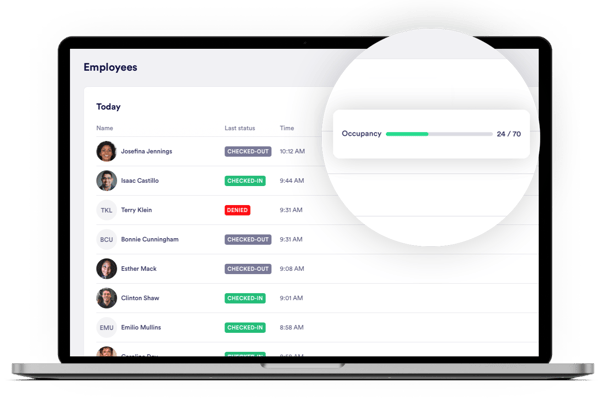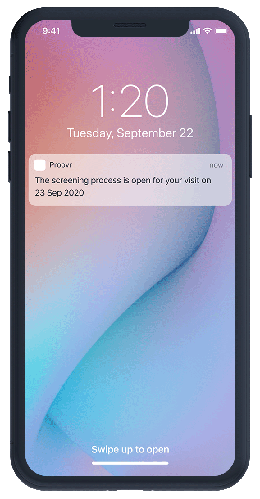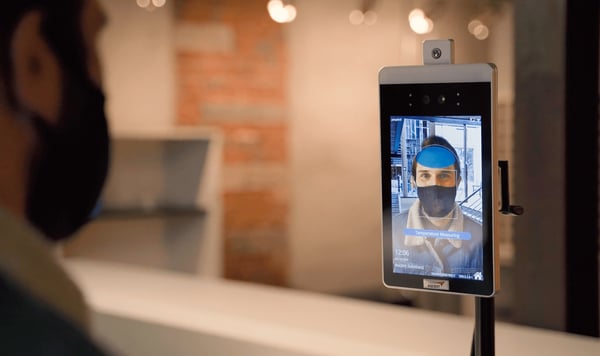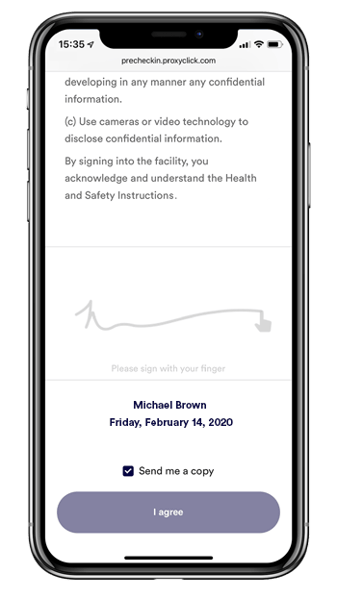How people flow management ensures workplace safety under OSHA

In the ever-evolving face of COVID-19, the U.S. government stresses the importance of people flow management with increasing urgency.
So once again, to do their part for public safety and stay on top of emerging regulations, companies across the nation are being called upon to re-evaluate their workplace COVID-19 prevention programs and make improvements wherever necessary.
Only 86% of organizations follow through with internal compliance program assessments. Meanwhile, fines for violations can exceed $130,000. - Osborne Clarke / Censuswide survey 2020
What is OSHA?
OSHA stands for the Occupational Safety and Health Administration, a US-based health and safety authority. OSHA's workplace safety inspections have reduced injury rates and costs, without harming "employment, sales, credit ratings, or firm survival."
What does OSHA protect?
OSHA's mission is to "assure safe and healthy working conditions for working men and women by setting and enforcing standards and by providing training, outreach, education and assistance."
To follow the executive orders passed after Biden’s administration took office, OSHA recently updated their COVID-19 guidelines to further bolster U.S. pandemic prevention efforts.
While these revised OSHA requirements might take a little legwork for organizations to comply with, they do come as welcome news. After all, faster-spreading strains of the virus are popping up with increasing frequency, making determined measures to keep the pandemic’s spread under control more vital than ever.
What are OSHA requirements for employers?
At the very least, complying with these regulations doesn’t have to be hard. That’s because flexible, cloud-based SaaS solutions like people flow management systems are well-equipped to address most of these adjusted OSHA standards for workplace safety.
To demonstrate how, let’s take a quick look at the actual requirements for employers enforced by Biden’s executive order protecting workplace safety and health, and how Proxyclick elevates workplace COVID-19 prevention programs to meet them.
1. Employers must provide workplace safety.
By Biden’s order and OSHA’s guidelines, the Secretary of Labor is to coordinate with States and ensure workers are sufficiently protected as defined by the Occupational Safety and Health Act (OSH Act) of 1970.
The OSH Act itself demands employers provide “a place of employment… free from recognized hazards that are causing or are likely to cause death or serious physical harm”. Of course, COVID-19 qualifies as such a hazard, making employers responsible for doing their utmost to keep workers infection-free.
Additionally, occupancy limits determined by available space and ventilation capabilities must be strictly followed in all communal work areas.
How Proxyclick addresses these orders:
Proxyclick helps keep the number of employees working alongside one another as low as possible with real-time monitoring tools that allow employers to enforce occupancy rates at all times.

Furthermore, the general risk of infection can be reduced through a combination of touchless check-in processes to avoid surface-borne infection and digital health questionnaires that screen for health risks before anyone approaches a worksite.
2. Employers must care for at-risk personnel.
The right of workers to seek safety becomes all the greater when they qualify as at-risk individuals.
This could mean anyone from elderly employees over 65, to those who are pregnant, struggling with cancer, or enduring any other number of conditions that impair the immune system. There’s an overwhelming variety of factors that make people more susceptible to the dangers of COVID-19, and they must all be protected with special care.
Of course, to better defend the vulnerable, work from home situations have become increasingly popular. But when remote situations aren’t possible, OSHA guidelines demand companies eliminate hazards by separating and sending home those who prove to be or are suspected to be, infected.
Meaning, as long as they were potentially exposed to the virus, even symptomless employees won’t be able to work until after their 14-day quarantine period ends.
How Proxyclick addresses these orders:
This is another area where remote health questionnaires prove invaluable. While they are not used for identifying at-risk individuals in Proxyclick, digital surveys can be customized to ensure that people with symptoms stay out of the building, therefore better protecting at-risk people.

Admins can also set daily occupancy limits in Proxyclick, and require employees to book their desks before their arrival, to ensure preventative social distancing measures are met.
With the Proxyclick Proovr app, allow entrance only to employees meant to be on-site on a given day. Employees can scan their mobile app directly from their smartphone against a unique QR code at the front desk kiosk, and easily gain contactless entry (provided they met all necessary workplace safety and health criteria during pre-registration).
"[With Proxyclick], check-in is now so simple. Staff just check in on their mobile phone, they don't have to touch the iPad kiosk. It's a touchless check-in, and that's really beneficial for us." - Emma Pritchard, CEO, Black Pear Trust
Upon entry, a touchless temperature scanner can be integrated with Proxyclick to provide an additional health and safety checkpoint for employees and visitors.

This way, unexpected health liabilities are restricted access, capacity limits are naturally kept low, and potential at-risk workers cannot endanger themselves by suddenly dropping by. (Visitors who do unexpectedly drop by, however, can be set up with a safe, secure touchless check-in process before they’re allowed on the premises).
"Proxyclick has been helpful in limiting and keeping track of our visitors on-site. One of the great things is that, when you do book a visitor to come in, they get an invitation email that tells them about any privacy notices in the school, or any safeguarding information. It's a really good system that enables us to do all of that." - Emma Pritchard, CEO, Black Pear Trust
If the case arises where a health risk does emerge in the workplace, all those on the premises, with their contact information securely stored in the system, can be immediately informed as part of contact tracing efforts.
3. Employers must always keep workers in the know.
OSHA mandates employers are obligated to provide employees adequate training “so that work will be performed in a safe and healthful manner”.
This includes instructing personnel on the full details of their workplace COVID-19 prevention program in a language they can understand. It also means updating employees on all relevant information as soon as it arises.
At the same time, employees are still legally owed the right to health privacy, meaning an infected individual’s information can’t be shared with anyone who hasn’t been directly exposed to them aside from the U.S. Department of Health & Human Services.
How Proxyclick addresses these orders:
Mandatory informational videos - in addition to workplace safety guidelines, images, and other important documents sent for signature in advance - are integrated into employee check-in flows to brief workers before they walk through the door.

Just as the pandemic will continue to change over time, the guidelines surrounding it will undoubtedly do the same, making check-in video briefings a leading method to keep everyone within a workplace informed enough to keep their co-workers and themselves free from harm.
4. Employers must record and report COVID-19 developments.
Lastly, OSHA’s revisions state every confirmed case of COVID-19 needs to be recorded and reported to health authorities without fail. That way contact tracing methods, which are critical to combatting this pandemic, can be carried out as efficiently as possible on a nationwide scale.
After reporting, it is also crucial that employers make sure any other spaces infected individuals occupied are thoroughly cleaned and disinfected to prevent further spread.
How Proxyclick addresses these orders:
Employee check-in and check-out features establish employee presence tracking that, in the case of COVID-19 exposure, is instrumental for contact tracing. Proxyclick allows admins to identify all people on the premises who may have been at risk of exposure on a given day, as well as contact them.
With these essential tools in place, every area an infected individual passes through is accurately monitored, revealing all employees that may have been exposed and every area where sanitization efforts are needed.
Master your workplace COVID-19 prevention program to meet OSHA standards
To sum it all up, implementing the right people flow management system can help organizations meet OSHA requirements for COVID-19 prevention in the workplace by:
- Limiting building occupancy to help with social distancing
- Sending digital health questionnaires to be answered prior to employee or visitor arrival
- Ensuring company health and safety protocols are sent, in written and video format, to all individuals prior to arrival
- Allowing for a touchless check-in process via mobile QR codes
- Indicating who's been in contact with at-risk individuals and retrieving their information for contact tracing
Useful resources
For more on navigating this pandemic in the workplace, check out these useful resources:
- Proxyclick's Return Ready COVID-19 resource center
- OSHA Emergency Response Plan
- How to implement a touchless check-in
- How to welcome unexpected visitors during COVID-19
To apply these solutions right away and better protect your employees in the return to the workplace, schedule a chat with one of our experts below.



